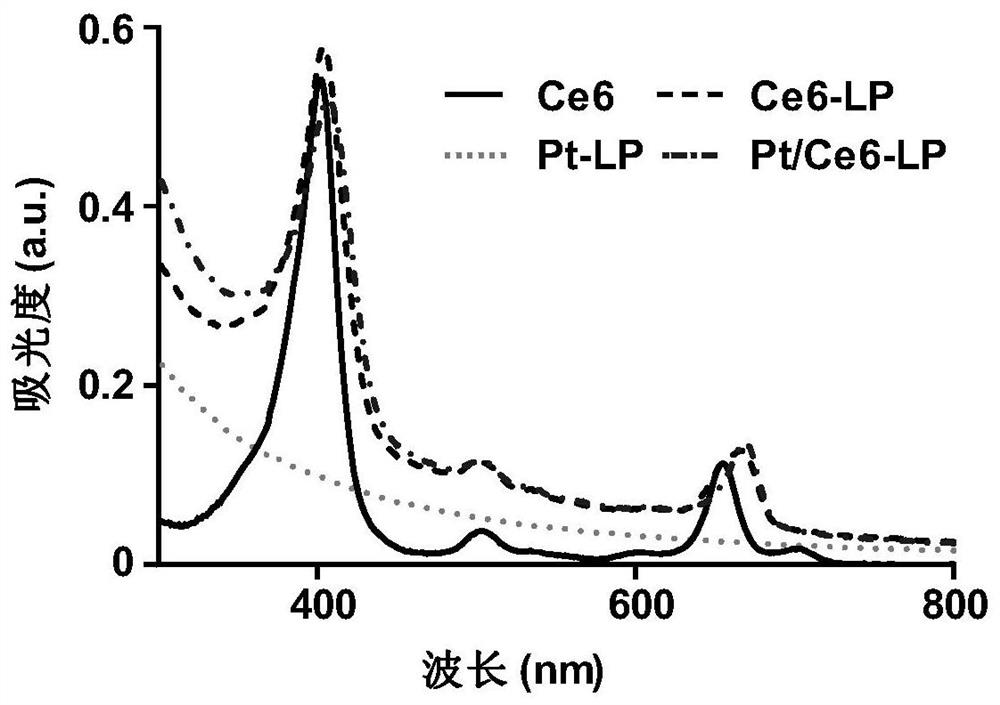Photosensitive liposomes and their applications
A liposome and photosensitive technology, applied in liposome delivery, photodynamic therapy, medical preparations of non-active ingredients, etc., can solve problems such as difficult to meet urgent needs, improve patient compliance, maintain effective concentration, The effect of restoring structural integrity
- Summary
- Abstract
- Description
- Claims
- Application Information
AI Technical Summary
Problems solved by technology
Method used
Image
Examples
preparation example Construction
[0042]The preparation method of the above-mentioned photoreceptic liposome can be prepared according to conventional photosensitive liposome, for example, various liposomes (at least one unsaturated phospholipid), photosensitizer, and active ingredients (for example, fat), photosensitizers and active ingredients (for example, lipids), photosensitizers and active ingredients (for example, lipids) Soluble anti-cancer drugs were cisplatin), dissolved in chloroform: methanol (5: 1) solution, 55-60 ° C and evaporated to remove organic solvent, resulting in dryness, uniformly attached to the glass bottle. Film. The obtained film was hydrated by ultrapure water to hydrate a homogeneous liposome solution, allowing the photosensitive agent in the concentration of 5-40 μg / ml in the photosensitive liposome. Then, the extrusion of the polycarbonate film (e.g., 100 nm of a pore diameter), and repeatedly squeezed several times, the quadrated cisplatin photoreceptic liposome was stored in 4 to...
Embodiment 1 4
[0062] Example 1 Preparation of tetrability cisplatin photoresist
[0063] (1) Materials and quantities: (5ml liposome), Table 1 below
[0064] Table 1
[0065]
[0066] (2) Preparation method
[0067] The various lipid materials (including unsaturated phospholipids), photosensitizers, and lipid-soluble anticancer drugs are weighed in Table 1, dissolved in 12 ml of chloroform: methanol (5: 1), 55-60 ° C The organic solvent was removed to remove the organic solvent to give a dry, uniformly attached to the film of the glass bottle. The resulting film was hydrated with 5 ml of ultrapure water to form a homogeneous liposome solution for 10 min. Then, the extrusion of the polycarbonate film, a pore diameter of 100 nm, and the acetate dialysis bag (MWCO: 3500 Da) was placed in water after dialysis 24 h after repeated extrusion. The obtained tetrability cisplatin photosensitive liposomes were stored at 4 to 7 ° C. The tetrability cisplatin photosensitive liposomes used in the followin...
experiment example 1 4
[0074] Experimental example 1 Characterization of tetrability cisplatin photorestated lesom
[0075] Using a Dynamic Light Scatterometer (DLS) to determine the quadrated cisplatin photorestoryctivomer and a quadrated cisplatin photosensitive liposome (0.5 W / cm) after 650 nm laser irradiation with 650 nm 2 , 3min) particle size, test results such as figure 1 As shown, the average particle diameter of the tetrability cis platinum photoinitrid is 128 nm. After laser irradiation, since the oxidation of phospholipids causes the film fusion of the tublatin permeable liposome, the tetraviolabus is bonded together, and the particle size of the photosensitive liposome is increased.
[0076] 10 μl of the prepared tetramiplatin photosensitive liposomes were taken with a pipette and laser irradiation with 650 nm (0.5 w / cm) 2 After 3 minutes, the quadratic copper side of the transmissive electron microscope (TEM) was dried overnight, and it was obtained after the plane was tested. figure ...
PUM
 Login to View More
Login to View More Abstract
Description
Claims
Application Information
 Login to View More
Login to View More - R&D
- Intellectual Property
- Life Sciences
- Materials
- Tech Scout
- Unparalleled Data Quality
- Higher Quality Content
- 60% Fewer Hallucinations
Browse by: Latest US Patents, China's latest patents, Technical Efficacy Thesaurus, Application Domain, Technology Topic, Popular Technical Reports.
© 2025 PatSnap. All rights reserved.Legal|Privacy policy|Modern Slavery Act Transparency Statement|Sitemap|About US| Contact US: help@patsnap.com



